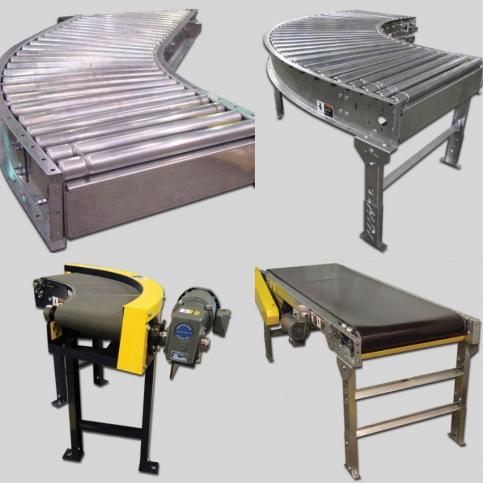Conveyor systems can have curved portions, requiring curved conveyors. These curves in systems provide direction changes and help save space within a facility.
Conveyor systems will typically consist of belts or rollers. Whether or not you use belts or rollers will depend on your applications and the product type.
What is the difference between belted and live roller conveyors?
Belt conveyors utilize two or more pulleys around which a belt is looped. When the pulleys rotate, the conveyor belt moves. Rollers or slider beds are placed under the belt to support products. These belts can be constructed of thermoplastics, metal, rubber, fabric, or leather. Different types of belt products produce more or less stability. In addition, the temperature will also impact the kind of material you choose to go for.
On the other hand, in live roller conveyors, the rollers are in direct contact with the conveyed products. As such, this can provide less stability, though roller conveyors are considered more economical. Due to their lesser stability, it is recommended to use them when the products being conveyed have flat bottoms.
This difference in stability will factor into your decision for choosing the right system for curved conveyors. Packages on roller conveyors can end up moving around or bumping into the guardrails, especially during curves. For these reasons, it is important to use belted or roller conveyors only if they fit your applications. Here are the applications that work for each type:
Belted Conveyors
- Irregular sized or small products.
- Changes in elevation.
- Products that are not in boxes with a flat bottom.
Two types of accessories can be used with belted conveyors: scanners and gappers or trackers. Scanners that are supported on slider beds can get the best read with belted conveyors. For gappers and trackers, belted conveyors offer more product control and reduce slippage.
Live Roller Conveyors
- Regular-sized products.
- Lack of ascending or descending.
- Packages with a flat bottom.
One of the benefits of live roller conveyors is the amount of accessories that can be used thanks to the spaces between the rollers:
- Package stops: Stopping accessories such as pins or blades can be raised between the rollers for traffic control, removal, quality inspection, and more.
- Diverting wheels: Divert wheels can be incorporated between the wheels and raised or lowered to move packages onto different paths.
- Lift bars: Lift bars help to raise cartons from the conveyor for secondary operations such as assembly or orientation rotation.
- Underneath scanners: Scanners can be installed underneath to catch barcodes between the gaps of the conveyor.
Overall, both belted and live roller conveyors work well with curved applications, but the specific choice for which type will depend on the kind of products you convey. Make sure to call the experts at Norpak Handling for more information on curved conveyor solutions.










